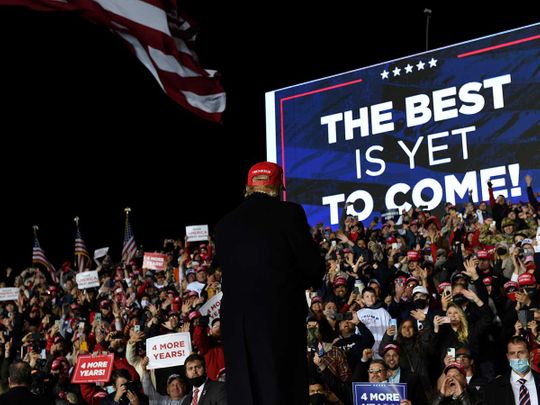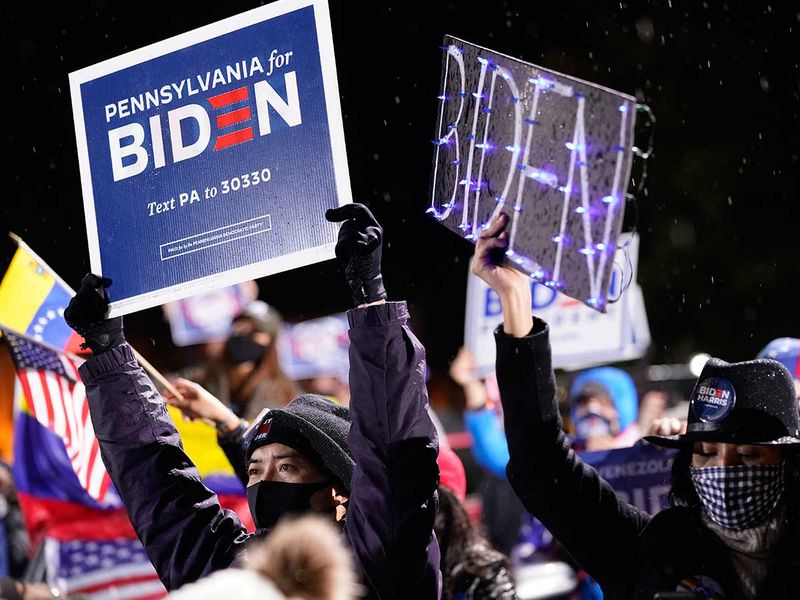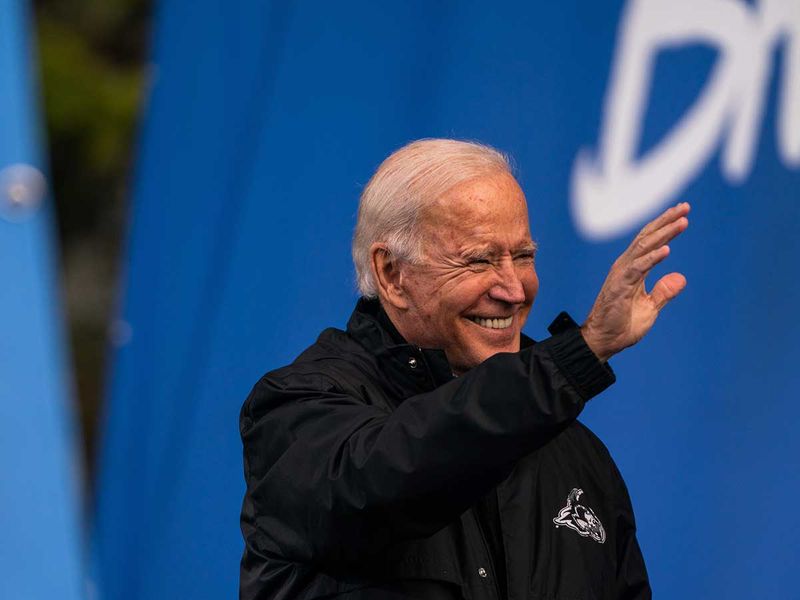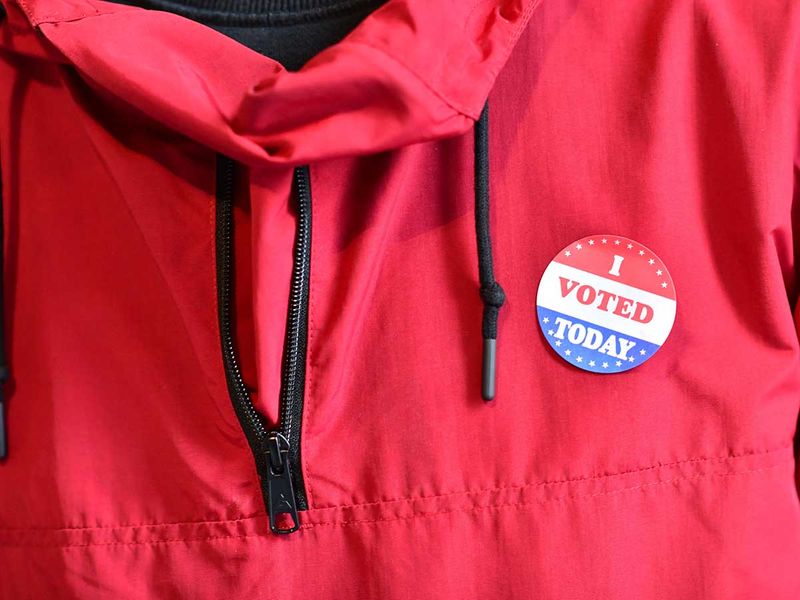
Washington: Election Day is finally upon us.
Or at least what we still call Election Day, since more than 92 million Americans have already cast ballots in an election that has been reshaped by the worst pandemic in more than a century, its economic fallout and a long-simmering reckoning with systemic racism.
Here are some key questions we are considering as the final votes are cast and counted:
WHAT DO AMERICANS WANT FROM A PRESIDENT?
Elections are always about where Americans want to steer the country. That’s especially true this year as the US confronts multiple crises and is choosing between two candidates with very different visions for the future.
President Donald Trump has downplayed the coronavirus outbreak even as cases surge across the US He has panned governors - virtually all Democrats - who have imposed restrictions designed to prevent the spread of the disease. And he has bucked public health guidelines by holding his signature campaign rallies featuring crowds of supporters - often unmasked - packed shoulder to shoulder.
His Democratic rival, Joe Biden, has said he’d heed the advice of scientists. He’s pledged to work with state and local officials across the country to push mask mandates and has called on Congress to pass a sweeping response package.

Trump casts protests of systemic racism as radical and has emphasized a “law and order” message to appeal to his largely white base. Biden acknowledges systemic racism, picked the first Black woman to appear on a major party’s presidential ticket and has positioned himself as a unifying figure.
The candidates also hold distinctly different views on everything from climate change and the environment to taxes and the scope of federal regulation.
WHOSE TURNOUT APPROACH WINS?
The two parties took wildly different approaches to contacting voters amid the pandemic.
Democrats stopped knocking on doors in the spring, going all-digital and phone. They resumed limited in-person contacts in September. Republicans continued traditional field work the entire campaign.
The GOP can point to success in increasing their voter registration in battleground states. Democrats can point to their early voting success, including from notable slices of new voters. But only the final tally will vindicate one strategy or the other.
WILL VOTING BE PEACEFUL?
Each major party can install official poll watchers at precincts. It’s the first time in decades Republicans could use the practice after the expiration of a court order limiting their activities. So it’s an open question how aggressive those official poll watchers will be in monitoring voters or even challenging eligibility.
The bigger issue is likely to be unofficial “poll watchers” - especially self-declared militias. Voter intimidation is illegal, but Trump, in the Sept. 29 presidential debate, notably refused to state plainly that he’d accept election results and instead said he is “urging my supporters to go into the polls and watch very carefully, because that’s what has to happen. I am urging them to do it.”
In Michigan, where federal authorities recently arrested members of anti-government paramilitary groups in an alleged plot to kidnap Democratic Gov. Gretchen Whitmer, the Democratic secretary of state tried to impose a ban on carrying firearms openly at a polling place. A Michigan judge struck down the order.
WHITHER THE EXURBS AND SMALLER CITIES?
Trump’s reelection depends on driving up his margins in rural areas and smaller towns and cities - those expansive swaths of red on the county-by-county results map from 2016.
But acres don’t vote, people do, and Biden is casting a wide demographic and geographic net. His ideal coalition is anchored in metro areas, but he hopes to improve Democratic turnout among nonwhite voters and college-educated voters across the map.
There are places where the competing strategies overlap: exurban counties - those communities on the edges of the large metropolitan footprints - and counties anchored by smaller stand-alone cities.
Two potential indicators that could have close-to-complete unofficial returns sooner than later and portend broader results:
FORSYTH COUNTY, GEORGIA - Part of metro Atlanta’s growing, diversifying northern ring. Republican Mitt Romney won 80% of 81,900 votes in 2012, while Trump’s share dropped to 70% of nearly 99,000 votes in 2016. If that trendline continues, it would signal first that GOP-controlled Georgia is indeed a tossup. More broadly, it would suggest Trump’s suburban-exurban problems are real.
MONTGOMERY COUNTY, OHIO - Dayton and its surroundings. They make up one of the 206 “pivot counties” that flipped from President Barack Obama to Trump. Obama won 51.4% of the vote in 2012 to 46.8% for Romney (Obama’s statewide win was 50.6-47.6). Trump nipped Hillary Clinton in 2016, but mostly because she lost 15,000 votes from Obama’s 2012 count (137,139), while Trump fell only about 950 votes short of Romney’s mark (124,841). A clear Biden rebound with a Trump drop-off is not the trend Republicans want to see in a midsize metro footprint.
A 1968 REDUX? HOW ABOUT 1980?
Trump spent considerable energy this year posturing as a “law and order” president, blasting nationwide protests of racial injustice and occasional violence as left-wing rioting that previewed “Joe Biden’s America.”
The president’s allies pointed to 1968, when widespread unrest amid the Vietnam War, general social upheaval and the assassinations of Martin Luther King Jr. and Robert F. Kennedy benefited Republican Richard Nixon as he built his “silent majority.” But Nixon wasn’t the incumbent in 1968. In fact, the political atmosphere was so bad for President Lyndon Johnson that the Democrat didn’t seek reelection.

Many Democrats and some Republicans are now pointing more at 1980, when Republican Ronald Reagan trounced President Jimmy Carter and the GOP flipped a whopping 12 Democratic Senate seats. Trump’s standing in the polls over 2020 has tracked only slightly above where Carter spent much of the 1980 election year, as he battled inflation, high unemployment and the Iran hostage crisis. But what appeared a tight race on paper as late as October turned into a rout. Even Democratic heavyweights like Indiana Sen. Birch Bayh and South Dakota Sen. George McGovern, once a presidential nominee, fell.
It’s a more polarized era four decades later. But the lesson is that Trump would defy history to win reelection amid such a cascade of crises and voter dissatisfaction.
WHEN WILL THE RACE BE CALLED?
Absentee voting amid coronavirus has changed the vote-counting timeline, and there aren’t uniform practices for counting those ballots. That makes it difficult to predict when certain key battlegrounds, much less a national result, could be called.
For example, Pennsylvania and Michigan - battlegrounds Trump won by less than 1 percentage point in 2016 - aren’t expected to have complete-but-unofficial totals for days. Florida and North Carolina, meanwhile, began processing early ballots ahead of time, with officials there forecasting earlier unofficial returns. But those two states also could have razor-thin margins.
Early returns, meanwhile, could show divergent results. Biden’s expected to lead comfortably among early voters, for example. Trump is likely to counter with a lead among Election Day voters. Depending on which counties report which batch of votes first, perennially close states could tempt eager partisans to reach conclusions that aren’t necessarily accurate.
US election lingo: A look at 'naked ballots' and 'red mirage'
Below is some of the jargon used in the days leading up to the Nov. 3 election pitting President Donald Trump against his Democratic challenger Joe Biden.
NAKED BALLOTS
Sixteen states, including Pennsylvania, require voters to return mail ballots in a special “secrecy” envelope. Ballots that don’t arrive in the envelope will be considered “naked” and might be disqualified. Celebrities including Naomi Campbell, Chris Rock and Sarah Silverman disrobed in a video to promote proper voting procedures, “the least sexy thing a completely naked person can say,” according to actor Josh Gad, who also stripped for the video by activist group Represent.Us. The group, which has promoted anti-corruption resolutions in US cities, says it does not endorse either candidate.
RED MIRAGE/BLUE SHIFT
Fearing crowded polling places amid the coronavirus pandemic, a record number of Americans, particularly Democrats, cast mail-in ballots this year, and counting them could take days. As a result, initial results on Election Day may show Republicans, indicated by red on election maps, holding large leads in battleground states such as Pennsylvania, which counts mail-in ballots received three days after Nov. 3. As ballots are tallied in the ensuing days, that “red mirage” could fade, giving way to a “blue shift.” Experts see a possible “blue mirage” and “red shift” in Florida and North Carolina, which process mailed-in ballots before Election Day.

SPOILED BALLOTS
Ballots that are improperly marked can be rejected as spoiled. Trump said in an Oct. 27 Twitter post that the phrase “can I change my vote” was trending on Google and urged Americans to submit a new ballot for him. Some states allow voters to request a new absentee ballot but first they have to request their original ballot be marked as spoiled. Following Trump’s tweet, Google data showed a spike in searches for “spoiled ballots.”
DUELING ELECTORS
A candidate becomes president by securing the most “electoral” votes rather than a majority of the national popular vote. The Electoral College system allots electors to the 50 states largely based on their population, and the candidate who wins the popular vote in a state generally gets its electors.
But legal experts say Trump could try to convince Republican lawmakers in closely contested states to approve the Republican slate of electors based on early vote tallies. As more ballots are counted, Biden might eventually be certified as the winner of the same state. The result: Dueling electors and an outcome that could be determined by Congress.
COURT PACKING
Republicans confirmed Amy Coney Barrett as a Supreme Court justice on Oct. 26 to replace the late Ruth Bader Ginsburg, a hero to many for her advocacy for women’s issues. Democrats had argued Ginsburg’s seat should be filled after the election and in response to Barrett’s confirmation some have suggested that a Biden Administration could expand the court beyond its traditional nine justices. The idea surfaced briefly in the late 1930s and was criticized as “court packing.” Biden has said he will establish a bipartisan commission to consider changes to the court system, which he said is “getting out of whack.”
POLL WATCHERS
The Republican National Committee is mobilising thousands of supporters to monitor early voting sites and ballot drop boxes, looking for irregularities such as people dropping off multiple ballots in states where that generally is not allowed. This marks the first presidential election in nearly four decades in which the Republicans can engage in “ballot security” activities without prior review and approval from the Department of Justice. Some voting rights advocates worry that gun-toting groups might show up outside polling places and intimidate voters.








